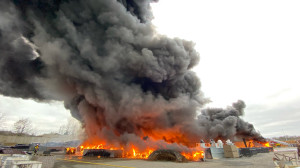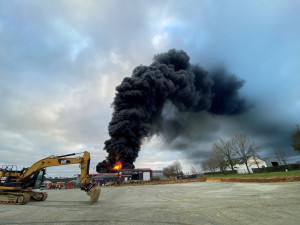At around 8 a.m., a fire broke out in a 2,500 m² building housing the rubber vulcanisation line in a plant specialising in processing recycled elastomer waste. Just after starting his shift, an employee noticed an orange glow from the vulcanisation line. Noting that the heater on the vulcanising press had caught fire, he attempted to extinguish the burning oil with a fire extinguisher, which caused the fire to spread. At this point, he triggered the fire alarm to alert the emergency services. The retention pond for collecting firefighting water was isolated. The fire spread to the storage racks to the left of the building and the stock of finished products (1,000 m³ of butyl and latex plastics and wooden pallets) located outside. A large plume of black smoke was released and visible for several kilometres. The personnel was evacuated, and inhabitants were confined indoors. The fire brigade arrived at around 8:30 a.m., and was able to bring the fire under control despite difficulties in obtaining a water supply, with the fire continuing in the outside storage area until 1:30 p.m.
Air quality measurements were conducted over a wider perimeter around the site by firefighters specialised in technological hazards, and the results were reassuring. Air samples were taken at several locations under the smoke plume to analyse other pollutants. The results of these 4 samples confirmed the results of measurements conducted on the day of the fire. The concentrations found throughout the site, at the property limit and in the hamlets downwind were well below the toxicological benchmark values.
Safety patrols during the night made it possible to identify several fire outbreeaks and bring them under control. Heavy equipment was used to spread out the fire residues. Outbreaks of fires occurred regularly over 3 days. Eight tanker trucks emptied part of the retention pond, i.e. 256 m³. The operator initiated regular rounds to monitor the pond.
Following the incident, the vulcanisation line remained out of operation for 10 months. A 10 t travelling crane was destroyed, and part of the structure and the entire roof and cladding of the vulcanisation line. A part of the roof of the building next to the latex and butyl lines and the partition between the two buildings were also destroyed. Among the resulting damage, the press reported that a machine worth €2.5 M had been destroyed inside the building.
The fire started in the rear of the vulcanising press’ oil heater. This recent machine had been installed at the site by its manufacturer, and had undergone regular maintenance. This heater was designed to heat vulcanisation moulds to 180 °C. The incident was caused by a rupture of a hose containing the heated oil inside the heater.
The operator took the following measures:
- initiation of the process to regularise its administrative situation to analyse the improvements to be made in terms of site safety;
- purchase of a new heater from a different manufacturer;
- raising awareness of the risks and consequences of fires and continued first-aid training for staff;
- increase in the number of islands with separation of storage areas to limit the risk of propagation to the finished product and raw materials storage area using concrete blocks, as required;
- updating of the formal risk assessment document (DUERP) regarding fire hazards;
- implementation of an incident register to identify recurring problems that may result in a disaster;
- limit the spread of fire between buildings, possibly by installing a firewall;
- identification of equipment presenting a risk of spillage of flammable products and confine them in a productive enclosure and provide retention facilities to prevent the spread of flammable products;
- installation of detection and autonomous extinguishing means near equipment at risk;
- sufficient water capacity for firefighter intervention;
- identify equipment presenting a risk and confine it within a protective enclosure;
- installation of detection and autonomous extinguishing means near equipment at risk;
- ensure sufficient water capacity for firefighter intervention.
Download the detailed report in .pdf format (958 Kb)






